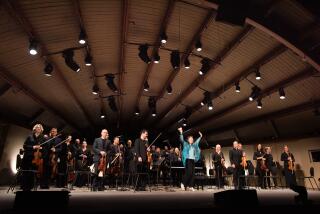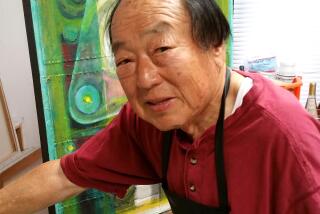A Harvest Moon Illuminates Kosaka’s Work
- Share via
If anyone understands and trusts the power of art, it ought to be the people who put together the World Festival of Sacred Music. However, the haunting, visionary conclusion to Hirokazu Kosaka’s performance art spectacle “Mare Tranquillitatis” was all but wrecked Saturday by the sponsors’ self-congratulatory speechmaking immediately afterward.
Staged on a large platform outside the Japan America Theatre, the performance drew its concept and multidisciplinary content from tributes to the harvest moon, with the moon itself appearing over the roof of the theater exactly at 9 p.m., as if on cue.
Moreover, the use of minimal stage lighting on a dark plaza left the moon the brightest object on view, outshining the braziers of burning, fragrant wood adjacent to the platform and just about everything else except the pesky camera-flashing that some ticket-holders inflicted on the event.
Initially, Kosaka seemed to be merely ritualizing a collection of moon-related world music and dance performances: the Okinawan classical “Moon-Viewing Dance,” for instance, by five women of the Majikina Honryu ensemble. Here hands rising symmetrically into overhead arcs or held out, as if the dancers were peering through them, ornamented spare walking steps and discreet extensions of a single foot.
The Hawaiian “Ka Mahina Malama” (The Moon That Cares) segment featured chanting by Clarice Wahineali’i Nuhi and dancing by Kapuakahi Abulon, with Abulon’s detailed gestural reinforcement of the text superimposed on graceful swaying hips.
Equally artful: the rich tone and embellishment in Karen Han’s solo on the classical Chinese mini-lute, the er hu. Or the unearthly wheezing pipes dominating antique Japanese court music played by the Kinnara Gagaku ensemble. Kosaka knew how to give our own moon viewing variety of effect without disturbing his deeply contemplative mood.
But it turned out that he had a more complex agenda than just staging a tasteful lunar revue--an agenda involving pieces of paper sculpted by the wind. Early on, as Kyokkaku Kawamoto played the chikuzen biwa or Japanese lute and sang passages from the epic “Heike Monogatari,” Kosaka shot an arrow across the stage into a large drum-like canister, releasing a spurt of silver and gray confetti.
Later, chanting priests of the Los Angeles Buddhist Church Federation cast into the air paper ovals printed with blossoms--and these “falling leaves” not only symbolized autumn but also the impermanence that Kosaka reiterated in his program notes.
In contrast, a fertility rite performed by members of Kosaka’s Ikkyu ensemble used the web-like explosion of rice-paper streamers normally associated with Noh and Kabuki spider-monsters to symbolize the procreative surge connecting two isolated beings and beginning a new life cycle.
The atmospheric accompaniment by Takeo Takahashi (shamisen) and Masakazu Yoshizawa (shakuhachi) invoked tradition, but Kosaka’s gymnastic people-towers created a dreamlike fusion of past and present.
At the end, as Keiko Takeshita sang an aria from Bach’s St. Matthew Passion, accompanied by violinist Mary Kay Tsuji, Kosaka shot another arrow into the night sky.
This time, a huge cascade of white paper discs floated down from the top of the five-story Japan America Gallery building and, while they fell, you could almost believe that Kosaka’s arrow had shattered the moon into this shower of gleaming fragments.
Obviously, celebrations of the harvest moon enrich many cultures with thanksgiving for abundance--and the hedge it offers against the cruelties of winter. But there’s sadness, too, in the knowledge that the year has turned and the dying part has begun.
By reminding us of this sadness, “Mare Tranquillitatis” invited the audience to reconsider its own place in the cycle of time: what part of the year our lives belong to and how soon we, too, will join the falling leaves.
More to Read
The biggest entertainment stories
Get our big stories about Hollywood, film, television, music, arts, culture and more right in your inbox as soon as they publish.
You may occasionally receive promotional content from the Los Angeles Times.










